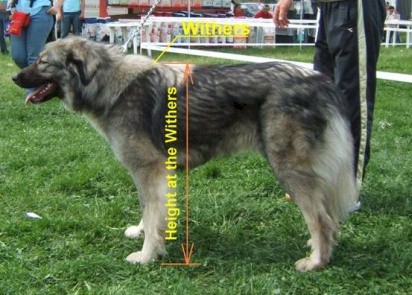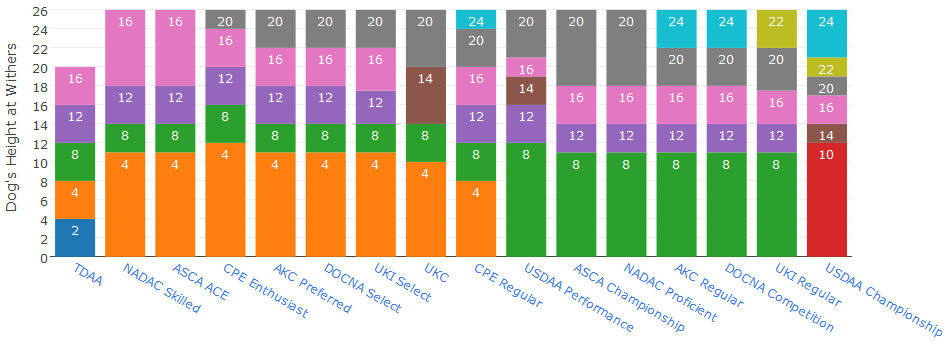
Frequently Asked Questions About Agility (FAQs)
- What is dog agility?
- How do I register my dog with USDAA?
- What obstacles are used in dog agility?
- How high will my dog have to jump?
- Can mixed-breed dogs participate in dog agility?
- What is USDAA's philosophy about dog agility?
- Are titles awarded in dog agility?
- Agility terminology
- For more information
What is dog agility?
Dog agility is a competitive sport in which a handler directs his dog over a timed obstacle course, with scoring based on faults as in equestrian jumping events. Because of its fast pace and simple, objective scoring system, dog agility has become an exciting spectator sport.
How do I register my dog with USDAA?
Go to the United States Dog Agility Association's Register with USDAA webpage, open an account, and complete the registration steps.
What obstacles are used in dog agility?
The approved obstacles for dog agility are the A-frame, weave poles, table, pause box, see-saw or teeter, dog walk, cross-over, pipe tunnel, collapsed tunnel, and assorted jumps and hurdles (including the broad jump, tire jump, high jump, bar jump, double bar jump, and spread jump).
 The
tunnel is made up of a flexible material sewn over circular ribs about
eighteen inches in diameter. Because of this flexibility, tunnels can be set
up in a variety of shapes and sizes. Tunnels are typically 15-20 feet long.
The
tunnel is made up of a flexible material sewn over circular ribs about
eighteen inches in diameter. Because of this flexibility, tunnels can be set
up in a variety of shapes and sizes. Tunnels are typically 15-20 feet long.
 The
dog walk consist of 3 planks, 10-12" wide and 12 feet long placed
end-to end. The middle plank is elevated to stand about four feet off the
ground.
The
dog walk consist of 3 planks, 10-12" wide and 12 feet long placed
end-to end. The middle plank is elevated to stand about four feet off the
ground.

The weave poles are a series of vertical poles placed 22 inches apart through which the dog must weave. The number of poles placed in a series ranges from six to twelve.
![]() The
pause table is a three foot square platform elevated between 12-26 inches,
depending on the height of the dog. The dog must jump onto the table and lay
down for a count of five seconds.
The
pause table is a three foot square platform elevated between 12-26 inches,
depending on the height of the dog. The dog must jump onto the table and lay
down for a count of five seconds.
 The
A-frame is typically two, three foot wide ramps that when standing together,
make a six foot ramp for the dog to climb.
The
A-frame is typically two, three foot wide ramps that when standing together,
make a six foot ramp for the dog to climb.
 Jumps
come in many shapes and sizes. The different types of jumps are wing,
wingless, broad or long, double, and triple. Jump heights range from 12-26"
depending on the dog.
Jumps
come in many shapes and sizes. The different types of jumps are wing,
wingless, broad or long, double, and triple. Jump heights range from 12-26"
depending on the dog.
 The
teeter (totter) or see-saw is an eight foot plank that is like a teeter in a
playground. The dog must go up the teeter and tip it under its own weight,
and continue down the plank to the end.
The
teeter (totter) or see-saw is an eight foot plank that is like a teeter in a
playground. The dog must go up the teeter and tip it under its own weight,
and continue down the plank to the end.

In the tire jump, the dog jumps through the round tire which is placed in the middle of a frame. As with other jumps, the height at the bottom of the tire ranges from 12-26" depending on the height of the dog.
How high will my dog have to jump?
 Measure
the dog's height in inches at the dog's withers -- top of the shoulder
blade.
Measure
the dog's height in inches at the dog's withers -- top of the shoulder
blade.
Click on
this
Dog Agility Jump Height Calculator to determine the
heights your dog will be jumping.
Can mixed-bred dogs participate in dog agility?
Yes. It is frequently said that dog agility is a sport for all dogs, in that the sport permits both purebred and mixed-bred dogs to compete. One should be aware however, that not all breeds are well suited for the sport because of physical build.
What is USDAA's philosophy about dog agility?
USDAA promotes dog agility as a sport in its own right as it offers enthusiasts a variety of competitive classes, such as gamblers, pairs relay, team, snooker, pairs and others. USDAA values the sport as a family sport, attracting men, women, children and the family pet.
Are titles awarded in dog agility?
Yes. The USDAA recognizes a dog's agility level on four levels through its structured classes for competition and performance. USDAA awards the Agility Dog title to the dog performing three clear rounds under the sports minimum standards. The Advanced Agility Dog, Masters Agility Dog, Performance Agility Dog, and the Agility Champion Dog are all titles each handler strives to achieve.
Agility terminology
Every profession, sport, or occupation has its own special vocabulary of terms, definitions, and slang. Agility is no exception. What follows are some of the more common (and not so common) agility terms. For those people not familiar with agility, the following vocabulary reveals some of the challenges of this exciting sport.
Back Jumping: Going over or through a jump or tire in the wrong direction.
Back Weaving: Going through the weave poles in the wrong direction.
Blind Change of Sides: Change of sides that takes place while the dog is in a tunnel.
Blocking: Handler movement that prevents the judge from seeing the dog hit or miss the contact zone. Also used when a handler attempts to prevent a dog from taking the wrong obstacle by standing in front of or "blocking" the dog's approach to the unwanted obstacle.
Clean Approach: Approaching a contact or jump from straight or nearly straight in front of it.
Clean Entrance: Approach to the weave poles from straight on or from the right side of the poles that does not require the dog to go around the first pole to enter correctly.
Contact: Any obstacle that requires the dog to touch a safety zone.
Contact Zone: The area on a contact obstacle painted yellow to designate the Safety Zone.
Counter-rotation: A method of tightening a dog's turn radius by turning into the dog rather than turning with the dog.
Course Faults: Any fault incurred while running a course. Errors such as refusals, displaced poles, missed contacts, off course, and handler errors are course faults.
Cross Over: Process where the handler goes from one side of the dog to the other. Can be classified into blind, static, and dynamic. Also called "Change of Sides." A "cross over" is also a large piece of equipment, similar to a dog walk but with four ramps instead of two. It is only used by a few organizations.
Crossing Pattern: Element of a course where the dog and handler will cross through a congested portion of the ring with obstacles on either side of the dog and handler.
Directionals: Any command given by the handler to turn the dog in a desired direction.
Doughnut: Any dog spinning completely around in a circle before or after an obstacle.
Dynamic Change of Sides: Change of sides performed with both the dog and handler visible to each other.
Exiting: Refers to the direction the dog will come out of the weave poles. Even number poles, the dog comes out to the left. Odd number, to the right.
Familiarization: Time set aside at the beginning of a day's competition where the dog and handler can get on the equipment prior to competition . Limited to Starters/Novice Dogs.
Flatten Out: A jumping problem where the dog takes off too soon (resulting in a flat rather than curved arc over the jump) and knocks down the bar.
Flyoff: The act of a dog leaving the teeter totter in an uncontrolled manner when the down side of the teeter is not close to the ground.
Front Cross: Any maneuver where the handler changes sides in front of the dog's direction of motion.
Gate Steward: Person responsible for getting dogs lined up and in the proper order.
Hard Left (or Right) Turn: A 90-degree turn to the left (or right) with minimal distance between the two obstacles requiring the dog to turn sharply between the first and second obstacle.
Impulsion: Dog's willingness to drive forward towards an obstacle withour handler coaxing.
Leading Off: Maneuver where the dog is placed on a wait at the start line and the handler moves away prior to starting the course.
Left One-Eighty (180): A series of three jumps that are performed in such a way that the dog makes a 180 degree turn to the left.
Left Two-Seventy (270): A turn over a series of jumps made to the left through 270 degrees such that the eventual exit dirction from the jumps will actually be to the right.
Push Out: Any maneuver where the handler gets the dog to move away from her/him.
Push/Pull: A method of teaching a dog weave poles, where the dog is alternately pushed or pulled through the poles on leash.
Pusher: Any dog who moves away from a handler more readily than towards a handler.
Rear Cross: Any maneuver where the handler changes sides behind the dog's direction of motion.
Right Side Weave: Situation where the handler is on the left side of the weave poles.
Right One-Eighty (180): A series of three jumps that are performed in such a way that the dog makes a 180 degree turn to the right.
Right Two-Seventy (270): A turn over a series of jumps made to the right through 270 degrees such that the eventual exit direction from the jumps will actually be to the left.
Runout: A specific type of refusal where a dog runs past the intended obstacle.
Scribe: Person who records faults for the judge.
Targeting: A training method where a motivator or
"target" is placed on an object or on a specific point on a course to get
the dog to focus on that given point.
Touch and Go: Process of hopping on
and off the table before the count.
Walk Through: The time given prior to the start of class for the handlers to walk and examine a course.
Zooming: Any dog who loses concentration and runs around the course in an uncontrolled manner. Also known as "Buzzing."
For more information
For more information about United States Dog Agility, contact the United States Dog Agility Association (USDAA).


CONNECT WITH US